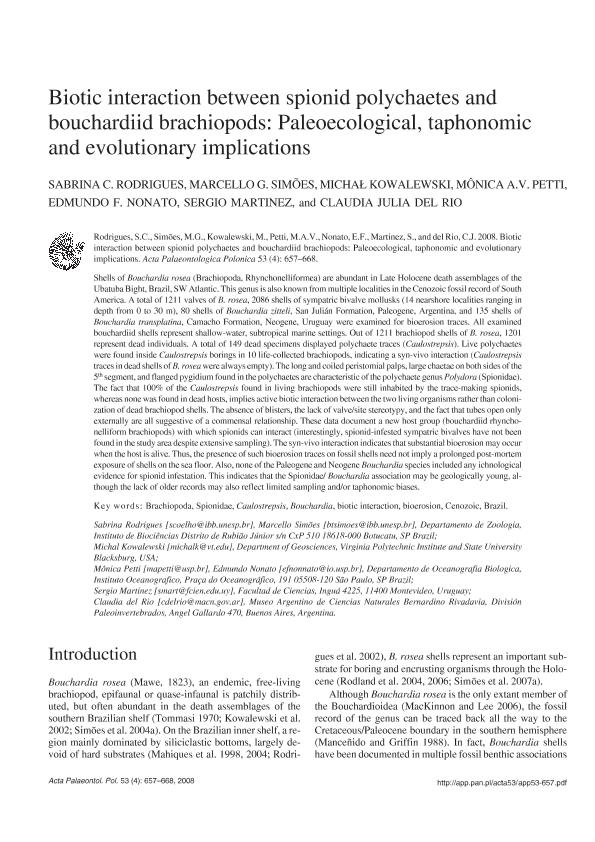Artículo
Biotic interaction between spionid polychaetes and bouchardiid brachiopods: Paleoecological, taphonomic and evolutionary implications
Rodrigues, Sabrina C.; Simões, Marcello G.; Kowalewski, Michal; Petti, Mônica A.V.; Nonato, Edmundo F.; Martinez, Sergio; del Río, Claudia Julia

Fecha de publicación:
12/2008
Editorial:
Polish Academy of Sciences. Institute of Paleobiology
Revista:
Acta Palaeontologica Polonica
ISSN:
1732-2421
Idioma:
Inglés
Tipo de recurso:
Artículo publicado
Clasificación temática:
Resumen
Shells of Bouchardia rosea (Brachiopoda, Rhynchonelliformea) are abundant in Late Holocene death assemblages of the Ubatuba Bight, Brazil,SWAtlantic. This genus is also known frommultiple localities in the Cenozoic fossil record of South America. A total of 1211 valves of B. rosea, 2086 shells of sympatric bivalve mollusks (14 nearshore localities ranging indepth from 0 to 30 m), 80 shells of Bouchardia zitteli, San Julián Formation, Paleogene, Argentina, and 135 shells of Bouchardia transplatina, Camacho Formation, Neogene, Uruguay were examined for bioerosion traces. All examined bouchardiid shells represent shallow−water, subtropical marine settings. Out of 1211 brachiopod shells of B. rosea, 1201represent dead individuals. A total of 149 dead specimens displayed polychaete traces (Caulostrepsis). Live polychaetes were found inside Caulostrepsis borings in 10 life−collected brachiopods, indicating a syn−vivo interaction (Caulostrepsis traces in dead shells of B. rosea were always empty). The long and coiled peristomial palps, large chaetae on both sides of the5th segment, and flanged pygidium found in the polychaetes are characteristic of the polychaete genus Polydora (Spionidae). The fact that 100% of the Caulostrepsis found in living brachiopods were still inhabited by the trace−making spionids, whereas none was found in dead hosts, implies active biotic interaction between the two living organisms rather than colonization of dead brachiopod shells. The absence of blisters, the lack of valve/site stereotypy, and the fact that tubes open only externally are all suggestive of a commensal relationship. These data document a new host group (bouchardiid rhyncho−nelliform brachiopods) with which spionids can interact (interestingly, spionid−infested sympatric bivalves have not beenfound in the study area despite extensive sampling). The syn−vivo interaction indicates that substantial bioerosionmay occur when the host is alive. Thus, the presence of such bioerosion traces on fossil shells need not imply a prolonged post−mortem exposure of shells on the sea floor. Also, none of the Paleogene and Neogene Bouchardia species included any ichnological evidence for spionid infestation. This indicates that the Spionidae/ Bouchardia association may be geologically young, although the lack of older records may also reflect limited sampling and/or taphonomic biases.
Palabras clave:
BRACHIOPODS
,
CAENOZOIC
,
BRAZIL
,
ARGENTINA
Archivos asociados
Licencia
Identificadores
Colecciones
Articulos(MACNBR)
Articulos de MUSEO ARG.DE CS.NAT "BERNARDINO RIVADAVIA"
Articulos de MUSEO ARG.DE CS.NAT "BERNARDINO RIVADAVIA"
Citación
Rodrigues, Sabrina C.; Simões, Marcello G.; Kowalewski, Michal; Petti, Mônica A.V.; Nonato, Edmundo F.; et al.; Biotic interaction between spionid polychaetes and bouchardiid brachiopods: Paleoecological, taphonomic and evolutionary implications; Polish Academy of Sciences. Institute of Paleobiology; Acta Palaeontologica Polonica; 53; 4; 12-2008; 657-668
Compartir
Altmétricas



